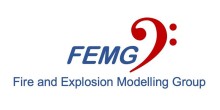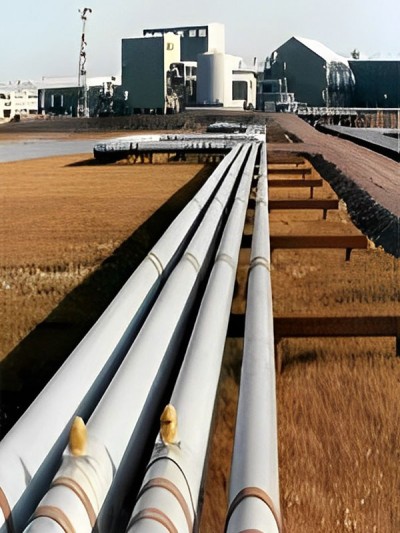

Pipeline safety
Carbon capture and storage technology involves the transport of compressed gas/liquid/dense phase carbon dioxide (CO2) via pipelines and process systems. Research has been conducted with industrial support on the decompression characteristics of rich gas and liquid/dense phase CO2 following pipeline rupture, to help determine the toughness required to arrest a running ductile fracture in a pipeline.
Computational fluid dynamics

CFD models for the decompression characteristics of rich gas and dense phase carbon dioxide (CO2) following pipeline rupture in the context of carbon capture and storage.
CFD-DECOM is a computational fluid dynamics model based on the arbitrary Lagrangian Eulerian (ALE) approach and the homogeneous equilibrium model (HEM) for simulating multi-phase flows, to predict the transient flow following rupture of pipelines conveying rich gas or pure carbon dioxide (CO2).
The benefits of using computational fluid dynamics are that it allows the effect of wall heat transfer and friction to be quantified. In CFD-DECOM, the former is considered through the implementation of a conjugate heat transfer model while the two-phase wall friction is computed using established correlations. The model was firstly validated for rich gas and to a limited extent dense phase CO2 decompression against the available shock tube test data. It was subsequently extended to both gaseous and dense phase CO2 with impurities.
The Peng-Robinson-Stryjek-Vera equations of state, which can predict the real gas thermodynamic behaviour of CO2 with impurities, has been implemented in addition to the Peng-Robinson and Span and Wagner equations of states. The liquid-vapour phase equilibrium of a multi-component fluid is determined by flash calculations. The predictions are compared with the measurements of some of the recent gaseous and dense phase CO2 shock tube tests commissioned by the National Grid.
Publications
H Jie, B P Xu, J X Wen, R Cooper and J Barnet, Predicting the decompression characteristics of carbon dioxide using computational fluid dynamics, Proc. 9th International Pipeline Conference, IPC2012, Sep. 24-28, 2012, Calgary, Alberta, Canada.
J X Wen, A Heidari, B P Xu and H Jie, Numerical simulations of carbon dioxide dispersion from vertical vent releases, 3rd International Forum on Transportation of CO2 by Pipeline, 20-21 June 2012, Newcastle, UK.
Carbon dioxide dispersion
CO2-FOAM, a dedicated solver for CO2 dispersion previously developed within the frame of the open source computational fluid dynamics code OpenFOAM® by the authors’ group, has been further extended to include the homogeneous relaxation model which is more suited to account for the presence of solid CO2 within the release.
The code offers both RANS and LES approaches, but only the RANS approach is reported in the present paper. In order to better capture the interaction between the dispersed CO2 and the ABL-specific boundary layer, a compressible form of the k- SST turbulence model is used in conjunction with ABL-specific wall-functions.
Predictions have been conducted for case study 3 in the COOLTRANS research programme. The CO2 was released through a puncture in a buried pipe. Evaluations of the different variations of the k- SST model suggested that the baseline k- SST model delivered the predictions that more closely matched the experimental measurements for the tests cases considered here.
The predictions have achieved reasonable agreement with the data based on a “blind validation”, giving confidence to the capability of CO2FOAM to be used for quantified risk assessment involving far field CO2 dispersions; especially for situations where screen tests with semi-empirical or integral models suggest more detailed consequence analysis.
To illustrate the application of the code, further predictions were conducted using the same release conditions as the baseline case but for scenarios involving a commercial building placed with its front face 25 m downwind of the release. The CO2 cloud wraps around and passes the building, generating turbulence as well as large flow oscillations and re-circulation zones.
The increased turbulence level due to the existence of the building would lead to more intense mixing and contribute to the dilution of the CO2 cloud. This effect is, however, decreased by buoyancy forces as density stratification in the flow tends to suppress turbulence generation. The building has a blocking effect to the flow, where the cloud can be trapped temporarily or diverted towards specific zones.
Publications
Jennifer X Wen, Pierre Le Fur, Hongen Jie and V. C. Madhav Rao, Further development and validation of CO2FOAM for the atmospheric dispersion of accidental releases from carbon dioxide pipelines, J of Greenhouse Gas Control, Vol. 52, Sep. 2016, Pages 293-304.
Jennifer Wen, Ali Heidari, Baopeng Xu and Hongen Jie, Dispersion of carbon dioxide from vertical vent and horizontal releases—A numerical study, Proc IMechE Part E:J Process Mechanical Engineering, 227(2) 125–139, IMechE 2013.
Richard Adoua, Pierre Le Fur, Jennifer Wen, The effect of obstacles and terrain on the dispersion of released carbon dioxide, 4th Int. Forum on Transportation of CO2 by Pipeline, June, 2013, Newcastle, UK.
Saturin Adoua, Pierre Le Fur and Jennifer X Wen, The effects of obstacles and terrain on the dispersion of released carbon dioxide, 4th Forum on Transportation of CO2 by Pipeline, 20-21 June 2012, Newcastle, UK.
Join us
If you are interested in undertaking a project with us then please contact us to discuss options.

Professor Jennifer Wen
Head of Fire and Explosion Modelling Group